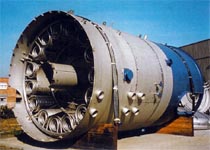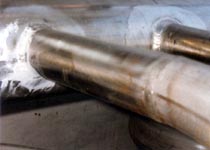
Figure 1.

Figure 2.

Figure 3.
Background
Enspec were asked to monitor the fabrication of a new stainless steel semicontinuous deodoriser (SCD) vessel used for deodorising vegetable and palm oils. The vessel was fabricated in sections and was constructed of type 316L stainless steel. One of the tray sections is shown in figure 1. The SCD's were normally manufactured according to the ASME code but the manufacturer was also capable of supplying the vessels to other codes, depending on the customer's requirements. It was stated that the high pressure stainless steel coils were always fabricated to the requirements of ANSI B31.3.
Findings
In general, the standard of fabrication was visually of a very high standard. One area of concern though was the edge preparation for the side-wall mounted actuator valve nozzle. This was a set-through configuration in the shell but the root gap was not uniform. This type of fabrication non-conformity could give problems when attempting to produce a full penetration weld.
Another problem area was the presence of acid pickling paste residues on some of the more inaccessible parts of the coils and the attachments to the shell. This feature is shown in figure 2 where there is a white residue on the surface of the welds and adjacent tube material. The white residue is barium sulphate which is used as a thickening agent to form an acid gel for application on vertical surfaces etc. The presence of the residue indicated that the acid paste had been left on the surface for an extended period of time, which is in contradiction to the paste manufacturers quoted maximum contact time of one hour.
The presence of acid pickling paste residue can potentially give rise to corrosion-related problems, both during manufacture and in service. In fact, evidence of corrosion in the form of rust staining was found on the coils as shown in figure 3. This had most probably been caused during the pickling of the coils by the failure to fully remove all traces of the pickling solution from the surface of the coils.
Key Points
- Enspec has encountered a number of corrosion-related failures in stainless steel process plant, resulting from overexposure of the acid pickling paste residue. In one particular case, the corrosion effect was so severe that it resulted in the complete replacement of a 42 ton vacuum vessel.
- It is important to implement Manufacturing Quality Inspections during construction. in order to identify any potential manufacturing non-conformities, the existence of which may compromise the operational reliability of the equipment.